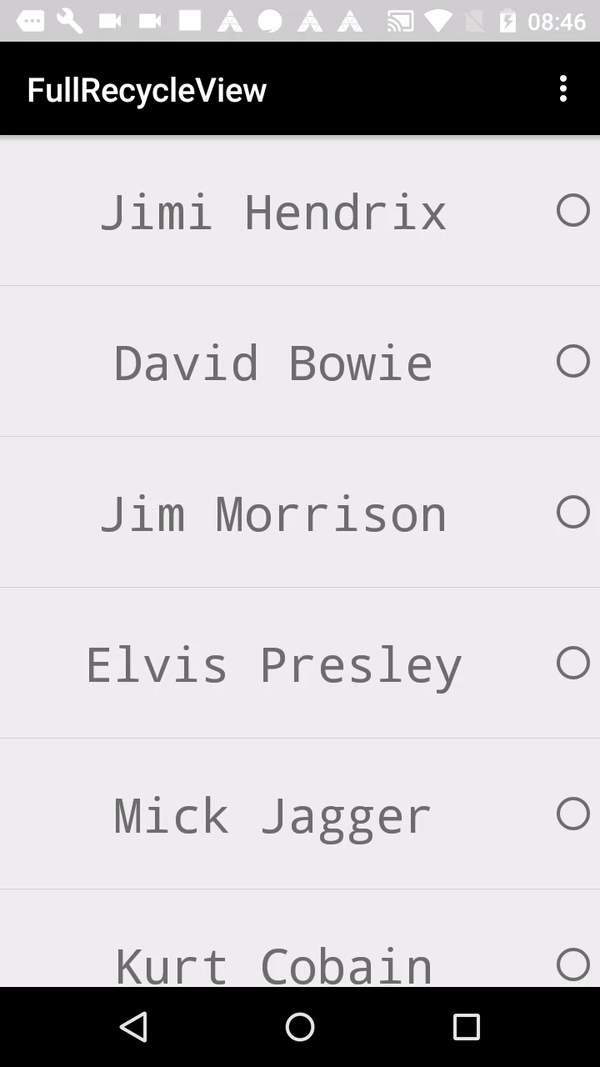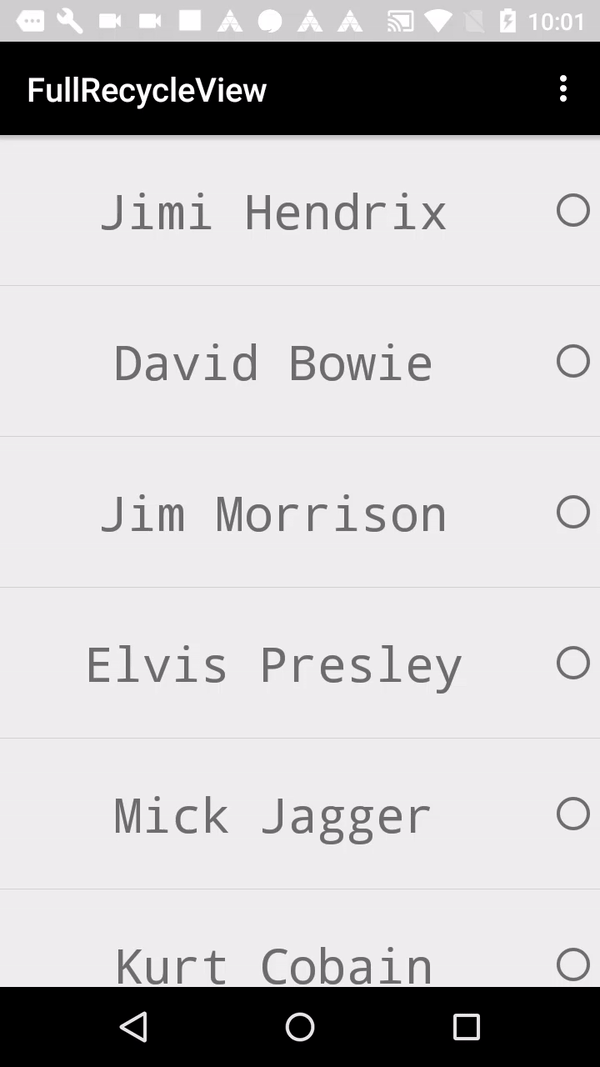Single choice recyclerView

When we want to Multiple choice in RecyclerView, we will need these things:
– String []
– Adapter with itemClickListener
– Activity or fragment
– activity_main (recyclerView)
– list_item (TextView, CheckBox)
We use notifydatasetchanged(), it’s very important than We understand this method.
You can check the full code in GitHub.
Our views activity_main.xml (recyclerView):
<RelativeLayout xmlns:android="http://schemas.android.com/apk/res/android"
xmlns:tools="http://schemas.android.com/tools"
android:layout_width="match_parent"
android:layout_height="match_parent"
tools:context="com.thedeveloperworldisyours.fullrecycleview.single.SingleFragment">
<android.support.v7.widget.RecyclerView
android:id="@+id/single_fragment_recycler_view"
android:layout_width="match_parent"
android:layout_height="wrap_content"/>
</RelativeLayout>
and list_item.xml (TextView, CheckBox)
<RelativeLayout xmlns:android="http://schemas.android.com/apk/res/android"
android:layout_width="match_parent"
android:layout_height="wrap_content">
<TextView
android:id="@+id/single_list_item_text"
android:layout_width="match_parent"
android:layout_height="90dp"
android:text="@string/app_name"
android:typeface="monospace"
android:layout_toLeftOf="@+id/single_list_item_check_button"
android:gravity="center"
android:textSize="@dimen/multiple_list_item_size_rock_stars"/>
<RadioButton
android:id="@+id/single_list_item_check_button"
android:layout_width="wrap_content"
android:layout_height="90dp"
android:layout_alignParentRight="true"
android:checked="false"
android:clickable="false"
android:focusable="false" />
</RelativeLayout>
Adapter with ClickListener
public class SingleRecyclerViewAdapter extends RecyclerView.Adapter<SingleRecyclerViewAdapter.DataObjectHolder> {
private String[] mData;
private static SingleClickListener sClickListener;
private static int sSelected = -1;
public SingleRecyclerViewAdapter(String[] mData) {
this.mData = mData;
}
static class DataObjectHolder extends RecyclerView.ViewHolder implements View.OnClickListener {
TextView mTextView;
RadioButton mRadioButton;
public DataObjectHolder(View itemView) {
super(itemView);
this.mTextView = (TextView) itemView.findViewById(R.id.single_list_item_text);
this.mRadioButton = (RadioButton) itemView.findViewById(R.id.single_list_item_check_button);
itemView.setOnClickListener(this);
}
@Override
public void onClick(View view) {
sSelected = getAdapterPosition();
sClickListener.onItemClickListener(getAdapterPosition(), view);
}
}
public void selectedItem() {
notifyDataSetChanged();
}
void setOnItemClickListener(SingleClickListener clickListener) {
sClickListener = clickListener;
}
@Override
public DataObjectHolder onCreateViewHolder(ViewGroup parent, int viewType) {
View view = LayoutInflater.from(parent.getContext())
.inflate(R.layout.single_list_item, parent, false);
DataObjectHolder dataObjectHolder = new DataObjectHolder(view);
return dataObjectHolder;
}
@Override
public void onBindViewHolder(DataObjectHolder holder, int position) {
holder.mTextView.setText(mData[position]);
if (sSelected == position) {
holder.mRadioButton.setChecked(true);
} else {
holder.mRadioButton.setChecked(false);
}
}
@Override
public int getItemCount() {
return mData.length;
}
interface SingleClickListener {
void onItemClickListener(int position, View view);
}
}
Activity or fragment
public class SingleFragment extends Fragment implements SingleRecyclerViewAdapter.SingleClickListener {
SingleRecyclerViewAdapter mAdapter;
public SingleFragment() {
// Required empty public constructor
}
public static SingleFragment newInstance() {
return new SingleFragment();
}
@Override
public void onCreate(Bundle savedInstanceState) {
super.onCreate(savedInstanceState);
}
@Override
public View onCreateView(LayoutInflater inflater, ViewGroup container,
Bundle savedInstanceState) {
// Inflate the layout for this fragment
View view = inflater.inflate(R.layout.single_fragment, container, false);
RecyclerView recyclerView = (RecyclerView) view.findViewById(R.id.single_fragment_recycler_view);
String[] list = new String[]{"Jimi Hendrix", "David Bowie", "Jim Morrison", "Elvis Presley",
"Mick Jagger", "Kurt Cobain", "Bob Dylan", "John Lennon", "Freddie Mercury", "Elton John", "Eric Clapton"};
mAdapter = new SingleRecyclerViewAdapter(list);
recyclerView.setAdapter(mAdapter);
recyclerView.setHasFixedSize(true);
RecyclerView.LayoutManager layoutManager = new LinearLayoutManager(getActivity());
RecyclerView.ItemDecoration itemDecoration =
new DividerVerticalItemDecoration(getActivity());
recyclerView.addItemDecoration(itemDecoration);
recyclerView.setLayoutManager(layoutManager);
mAdapter.setOnItemClickListener(this);
return view;
}
@Override
public void onItemClickListener(int position, View view) {
mAdapter.selectedItem();
}
}



